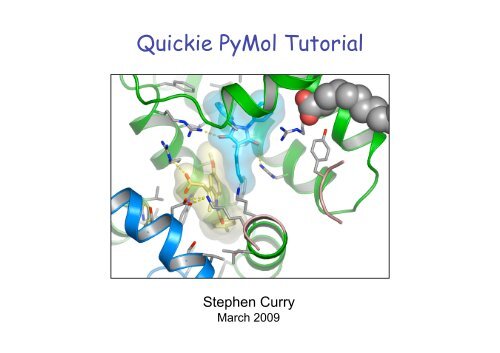


Kalju Kahn, Department of Chemistry and Biochemistry, UC Santa Barbara.Pymol is a Python-based molecular viewer that is used for multiple purposes. You can insert PNG image files into your Office documents by selecting Insert -> Picture -> From File. Incorporate this image into your lab report. Inspect your work think if this was a good color combination for distinguishing the two strands of DNA? Once you have decided on best colors, save your image using the Save Image As. Click on any atom in the other chain to select it, and color it firebrick from red. Now select a Color such as smudge from greens. Now left-click on any atom in one of the chain notice that the whole chain is selected. Left-click of the field until it says Chains. It says Residues by default, but you want to select chains. Notice the green Selecting field near the bottom of the task bar. You can change the appearence of individual objects, such as DNA using the menu items under these letters. Notice the two rows, labeled all and DNA. These letters stand for Actions, Show, Hide, Label, and Color, respectively. Notice the five columns, labeled | A | S | H | L | C | in the task bar on the right side. Rotate the molecule into upright position by clicking and dragging with the left mouse button. Load the DNA molecule that you already studied in PyMOL by typing pymol. The commands are explained in the PyMOL manual. This is the most powerful way to interact with the program, but requires that you are familiar with the logic and syntax of PyMOL commands. For example, you can create dashed lines (a good way to show hydrogen bonds) between oxygens and nearby amide hydrogens in the alpha-helix by using a command "dist (helix and name o), (helix and (name h and neighbor name n)), 2.5". The command line allows you to type in commands that can accomplish almost any of PyMOL's functions.For example, you can select two atoms (first by CTRL-SHIFT/left-clicking, second by CTRL-SHIFT/right-clicking ) and create a covalent by pressing CTRL-T. Furthermore, you can select and perform specific tasks via mouse and keyboard shortcuts. Your three-button mouse allows you to rotate, move, and zoom in/out by holding down the left, middle, or right button, respectively. The molecular display area allows to one view and interactively manipulate molecules.For example, you can show your protein as a gray surface and the inhibitor as green sticks if you have separated them into two different objects. A task bar on the right side of the screen allows one to select which objects are displayed in which way.For example, you can change the display quality settings, the background color, the size of your spheres, or the transparency of the surface from the pull-down menus. Pull-down menus provide access to the file functions, the molecular editor, the program options, and a few more advanced tasks.You can interact with the program via four complimentary ways

As a result, it takes a little time to learn the program. During the early development, emphasis was placed on providing functionality, and not on intuitive user interface. At the present time the program is still undergoing active development, but it is mature enough to be used for learning and research. Two unique and valuable features of this program over some other visualization program are the use of the powerful programming language ( Python) and an emphasis on high-quality graphics. It can also perform many other valuable tasks (such as editing PDB files) to assist you in your research. Warren DeLano, PyMOL is a molecular graphics system with an embedded Python interpreter designed for real-time visualization and rapid generation of high-quality molecular graphics images and animations. For example, it is not designed for building molecules or performing many types of calculations that commercial programs such as SYBYL do.Īccording to the program's author, Dr. PyMOL is not as capable as SYBYL in some areas. A secondary reason is that PyMOL offers a uniquely powerful way to create remarkably stunning images and animations that help to understand molecules under study.
#Pymol tutorial download
The main reasons of using a program such as PyMOL are affordability and accessibility: as a student you can download an educational version for free, and use it with any computer you have, be it Windows, Mac, or Linux. You will continue mastering this skill today with the help of another molecular visualization program, PyMOL.
#Pymol tutorial how to
But more importantly, you started learning how to think about the properties and functions of biological macromolecules via computer visualization. Welcome back to the molecular visualization tutorial! In the previous session, you became familiar with the Unix operating system, and learned some basic features of the program SYBYL. PyMOL Tutorial: Introduction Chem 110L: Macromolecular Visualization Laboratory Exercise: PyMOL


 0 kommentar(er)
0 kommentar(er)
